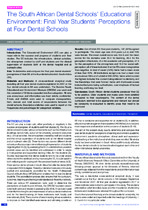The South African dental schools’ educational environment: Final year students’ perceptions at four dental schools
Date
2018Author
Bhayat, Ahmed
Barrie, Robert
Motloba, Pagollang
Yengopal, Veerasamy
Metadata
Show full item recordAbstract
Introduction: The Educational Environment (EE) can play a major role in the success and progress of students and their studies. The EE includes the infrastructure, clinical activities, the atmosphere created by staff and students and the clinical supervision of students both at the dental hospital and at outreach sites.
Aim: To determine and compare the final year dental students’ perceptions of their EE at the four dental schools in South Africa (SA).
Materials and Methods: A cross-sectional analytical study including all final year dental students registered in 2017 at the four dental schools in SA was undertaken. The Dundee Ready Educational and Environment Measure (DREEM) was used and this consisted of 50 items separated into five categories. All data was anonymous and information was kept strictly confidential. T-tests and ANOVA were used to compare demographics, item, domain and total scores of respondents between the dental schools. Descriptive statistics were used to report on the frequencies and percentages for categorical variables.
Results: Out of total 210 final year students, 141 (67%) agreed to participate. The mean age was 23.9 years (±2.4) and 72% were female. The mean overall score was 124.5 and the mean scores for the domains were 30.3 for learning, 26.2 for the perception of lecturers, 23.4 for academic self-perception, 27.9 for the perception of the atmosphere and 16.2 for social self-perception; all of these indicated that the EEs were more positive than negative. A total of seven (14%) items had a mean score of less than 50%. All institutions except one, had a mean total score above 100 out of a total of 200 (50%). Items which scored the highest included the content being relevant to dentistry and the friendships that were formed. Items with the lowest scores included lecturers being authoritarian, over-emphasis of factual learning and being too tired.
Conclusion: South African dental students perceived their EE to be positive. Older students and males were more satisfied compared to their counterparts. The content of the dental curriculum seemed to be appropriate and relevant but should be constantly re-evaluated to identify areas that need to be improved.

